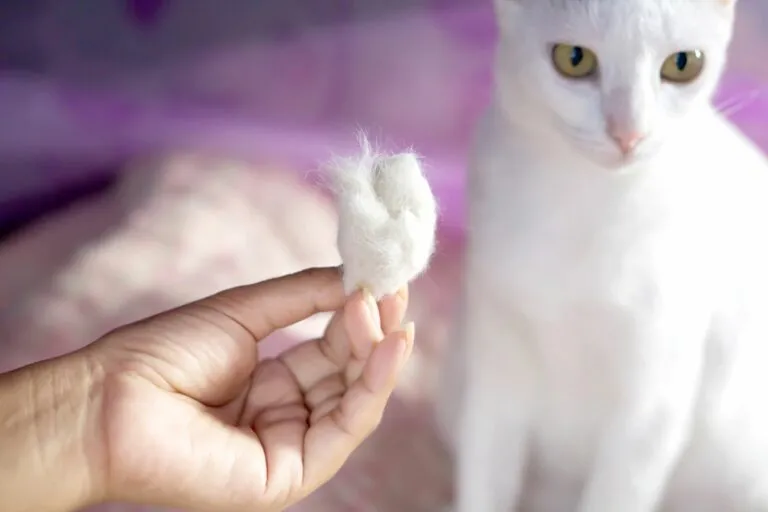Hair loss (alopecia) in cats can occur physiologically due to seasonal moulting, or can also be pathological. Parasites, hormonal disorders or hereditary hair formation disorders are just a few examples of the causes of hair loss in cats:
How does hair loss in cats come about?
Hair loss isn’t a stand-alone illness, but a sign of a disease. Thus, for a better overview, alopecia is divided into genuine hair loss (due to causes not related to itching) and apparent hair loss (due to itching and scratching):
1. Causes not related to itching:
- Hormonal disorders: hair formation takes place in three different phases, which is controlled by various growth hormones. Amongst other things, they are influenced by the hormones of the adrenal glands or thyroid gland, therefore diseases relating to these organs can also lead to hair loss. With cats, hyperthyroidism is particularly often observed as a cause for hair loss.
- Hereditary diseases, which lead to functional or structural problems with the hair roots (e.g. follicular dysplasia)
- Skin infections due to bacteria (e.g. staphylococci or streptococci) as well as fungi (e.g. Malassezia or dermatophytes).
- Tumourous events
- Stress
2. Causes related to itching:
- Ectoparasites like fleas, ear mites and hair follicle mites
- Allergic reactions (e.g. due to pollen, house dust mites or perfumed cat litter)
- Bacterial and fungal infections can also lead to hair loss in cats due to itching
What symptoms emerge along with hair loss?
Cats can show hair loss on their entire body or certain parts of it. The shape, extent, temporal occurrence (acute or chronic) and symmetry also vary depending on the cause. It’s not uncommon for affected cats to also suffer from further symptoms depending on the underlying disease:
- Hair loss caused by itching is generally caused by scratching and increased licking of the affected areas of the skin.
- Hormonal disorders like hyperthyroidism in cats often induce weight loss despite increased food consumption. Gastrointestinal problems or an increased activity level are often observed.
- Bacterial infections may be accompanied by purulent wound secretion and in severe cases can lead to fatal sepsis. In the course of the event, cats show a severely reduced general condition and high fever.
What diagnostic measures are possible?
Due to the many causes of hair loss in cats, it’s advisable to get advice from a vet. During the owner interview, information about parasite prevention up until now or methods of feeding and methods can give important indications. There are also questions about sudden changes in character or the emergence of further symptoms (e.g. diarrhoea, vomiting, fatigue).
After the vet has determined the current state of health in a general clinical examination, they can proceed with a thorough inspection (adspection) of the affected skin areas. If a purulent secretion can be seen on the skin, for instance, this can be a sign of a bacterial skin infection (pyoderma). If the hairs are merely broken off, hair loss caused by itching is more strongly suspected.
Unfortunately external signs don’t always indicate the cause, therefore in some cases a greater amount of time is needed for a secure diagnosis. The following diagnostic measures can help in this respect:
- A blood test can allow signs of inflammation, allergic reactions and parasite infestation or diseases affecting different organs (e.g. the liver) to be found.
- A skin test (intradermal test) or antibody test (in-vitro test) can also be carried out to clarify allergic reactions. Elimination diets too help to diagnose food allergies.
- Hormonal disorders can be identified with special hormone tests.
- A trichogram can be used to determine the hair cycle. Individual hairs are observed under the microscope and then examined based on their characteristics.
- Surrounding skin layers can be examined with a biopsy on inflammatory cells, bacteria and parasites.
How is hair loss treated?
In order to combat hair loss in cats, targeted treatment of the cause is necessary:
- Bacterial infections generally heal up over several days after regular wound cleaning. In some cases, more severe courses also require antibiotics in the form of ointments and/or tablets following a resistance test.
- A parasite infestation can be treated with medication.
- In some cases, hair loss due to an allergy requires cortisone preparations. Removing the antigen from the cat’s environment also helps symptoms to subside.
- Hormonal disorders can be treated with medication or surgery depending on the cause in question. For instance, hyperthyroidism can subside with radiotherapy.
- Tumours require radiotherapy or chemotherapy depending on the type of cells. Surgical procedures can also be curative.
Discover our selection of cat food for skin problems!
What is the prognosis?
Hair loss itself is no big problem for most cats. Nevertheless, severe illnesses can underlie the symptoms. Hence, the prognosis greatly depends on the origin and treatment. However, the hairless skin areas generally disappear quickly if the underlying disease can be treated successfully.
Can hair loss be prevented in cats?
Some reasons for the emergence of hair loss in cats can be counteracted at an early stage. In this sense, special collars or spot-ons can be used as parasite prevention, which tackle mites, fleas and ticks with pyrethroids. A balanced diet and good housing conditions can also counteract underlying diseases.
